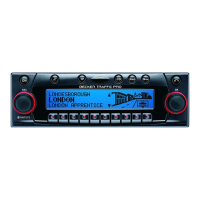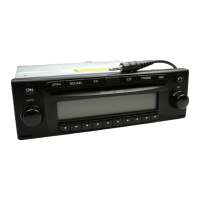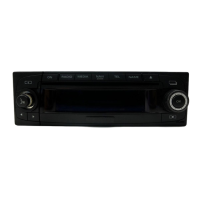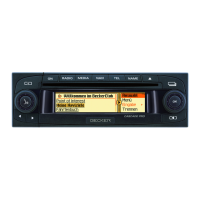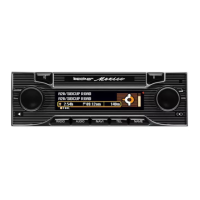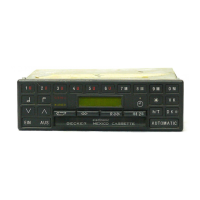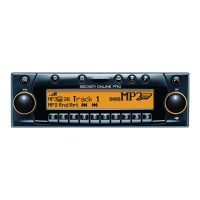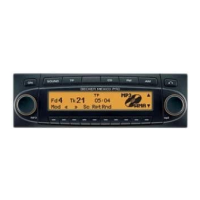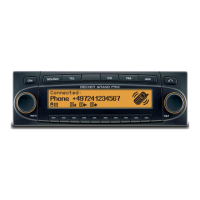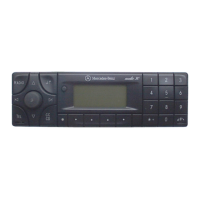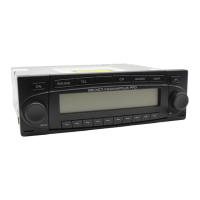Do you have a question about the Becker Traffic Pro 7945 and is the answer not in the manual?
Important safety warnings and limitations related to navigation usage.
Storing a destination in the address book for future use.
Transferring a fast access entry to the main address book.
Finding and navigating to destinations stored in the address book.
Display of real-time navigation information, including turns and ETA.
Accessing and selecting options during route guidance.
How to abort the ongoing route guidance.
Displaying and listening to traffic information relevant to the route.
Adding an intermediate destination during active navigation.
Removing a previously entered stopover.
Changing route preferences like dynamic, quick, or short routes.
Viewing details about the destination, including speed and distance.
Viewing and saving the vehicle's current location.
Accessing and listening to traffic information messages.
How dynamic route guidance utilizes TMC for traffic updates.
Enabling the system to recalculate routes based on traffic.
How the system receives traffic information via TMC.
Accessing and listening to detailed traffic announcements.
Setting preferences for traffic messages and arrival announcements.
Configuring automatic reading of traffic announcements.
Adjusting how the Estimated Time of Arrival is calculated.
Configuring automatic announcement of calculated arrival times.
Selecting calculation methods for ETA (Sports Car, Van, Car).
Activating the radio function and selecting last station.
Accessing the main menu for radio mode settings.
Viewing additional information broadcast by FM stations via RDS.
Selecting settings to suppress reception interference.
Utilizing TP to receive traffic announcements.
Specifying whether to listen to traffic news on a specific station.
Manually choosing a station for traffic news.
Switching to media mode to play audio or MP3 media.
Accessing lists of available media sources and directories.
Details shown on the media status display, including medium and track type.
Accessing the menu for play mode functions.
Activating random playback of tracks.
Accessing the main menu for media mode settings.
Copyright laws and usage restrictions for MP3 files.
Guidelines for preparing MP3 files and folders on storage media.
Compatibility and usage for memory cards and micro-drives.
Connecting and operating external audio sources via AUX.
Information on using a Bluetooth®-enabled phone with the Traffic Pro.
Details on supported Bluetooth® profiles and phone compatibility.
Important safety notice regarding mobile phone usage in the vehicle.
Steps to activate the telephone mode.
Accessing the main menu for phone functions.
Overview of available functions in the telephone main menu.
Entering and dialing telephone numbers directly.
Choosing and calling a number stored in the address book.
Viewing lists of missed, dialled, and answered calls.
Removing an entire call list from the device.
Making an emergency call to the 112 number.
Configuring the unit to automatically answer incoming calls.
Enabling voice dialogue for answering incoming calls.
Information shown during an active telephone call.
How to accept or reject incoming calls.
Steps to reject a call and hear a busy signal.
Procedure for terminating a current phone call.
Accessing options like ending call, DTMF, or call divert.
Transmitting DTMF tones for interactions like answering machines.
Diverting calls to the mobile phone, deactivating hands-free.
Viewing last 20 dialled, answered, or rejected numbers.
Initiating a call directly from the fast access list.
Storing phone numbers in the address book.
Accessing the main address book.
Accessing the menu for address book operations.
Process for creating a new entry, including name and address.
Creating entries that support direct navigation.
Option to record voice tags for address book entries.
Searching for entries by name or town.
Choosing to search by name or by town.
Modifying data within an existing entry.
Transferring a single entry to another Bluetooth® device.
Transferring the whole address book via Bluetooth®.
Transferring a single entry to another Bluetooth® device.
Receiving entries from an external Bluetooth® device.
Starting route guidance directly from an address book entry.
Initiating a call to a stored address book contact.
Using fast access for frequently called contacts.
Accessing the main settings menu for system configuration.
Overview of Bluetooth® functionality and connection.
Viewing connected or available Bluetooth® devices.
Configuring devices to connect automatically.
Procedures for establishing and terminating connections with external devices.
Steps to connect devices to the Traffic Pro via Bluetooth®.
Accessing the Bluetooth® configuration menu.
Turning the Bluetooth® feature on or off.
Initiating a scan for available Bluetooth® devices.
Accessing settings related to voice control.
Selecting the language for system announcements and displays.
Adjusting the volume for system announcements and voice prompts.
Specifying events that trigger automatic voice dialogues.
Replaying the last navigation announcement or updated prompts.
Configuration options for volume, vehicle type, and display.
Resetting the unit to factory settings.
Adjusting volume automatically based on vehicle speed.
Specifying vehicle drive type for loudspeaker transmission.
Adapting digital audio source volume to analogue sources.
Resetting the unit to factory settings.
Setting GMT time, format, and time zone for accurate navigation.
Instructions for updating the unit's software via CD.
Monitoring the progress of the software installation.
Confirmation message and restart procedure after update completion.
Principles for optimizing voice command recognition.
Steps to enable voice recognition for operation.
Creating voice tags for stations and address book entries.
Customizing voice mode operation for user experience.
Step-by-step guide for using voice commands in radio mode.
Voice command sequence for inputting a destination address.
Voice command sequence for dialing a phone number.
Core voice commands for navigating system menus and displays.
Voice commands for station selection and mute functions.
Voice commands to access options and main menus from the radio status display.
Voice commands for selecting, editing, and managing radio stations.
Voice commands for accessing TP, voice entries, regionalisation, and reception optimisation.
Voice commands for track and CD selection in media mode.
Voice commands for accessing media main menu and drives.
General voice commands for route guidance and stopovers.
Voice commands for accessing telephone menus and dialing.
Voice commands to access phone number input and address book.
Important safety warnings and limitations related to navigation usage.
Storing a destination in the address book for future use.
Transferring a fast access entry to the main address book.
Finding and navigating to destinations stored in the address book.
Display of real-time navigation information, including turns and ETA.
Accessing and selecting options during route guidance.
How to abort the ongoing route guidance.
Displaying and listening to traffic information relevant to the route.
Adding an intermediate destination during active navigation.
Removing a previously entered stopover.
Changing route preferences like dynamic, quick, or short routes.
Viewing details about the destination, including speed and distance.
Viewing and saving the vehicle's current location.
Accessing and listening to traffic information messages.
How dynamic route guidance utilizes TMC for traffic updates.
Enabling the system to recalculate routes based on traffic.
How the system receives traffic information via TMC.
Accessing and listening to detailed traffic announcements.
Setting preferences for traffic messages and arrival announcements.
Configuring automatic reading of traffic announcements.
Adjusting how the Estimated Time of Arrival is calculated.
Configuring automatic announcement of calculated arrival times.
Selecting calculation methods for ETA (Sports Car, Van, Car).
Activating the radio function and selecting last station.
Accessing the main menu for radio mode settings.
Viewing additional information broadcast by FM stations via RDS.
Selecting settings to suppress reception interference.
Utilizing TP to receive traffic announcements.
Specifying whether to listen to traffic news on a specific station.
Manually choosing a station for traffic news.
Switching to media mode to play audio or MP3 media.
Accessing lists of available media sources and directories.
Details shown on the media status display, including medium and track type.
Accessing the menu for play mode functions.
Activating random playback of tracks.
Accessing the main menu for media mode settings.
Copyright laws and usage restrictions for MP3 files.
Guidelines for preparing MP3 files and folders on storage media.
Compatibility and usage for memory cards and micro-drives.
Connecting and operating external audio sources via AUX.
Information on using a Bluetooth®-enabled phone with the Traffic Pro.
Details on supported Bluetooth® profiles and phone compatibility.
Important safety notice regarding mobile phone usage in the vehicle.
Steps to activate the telephone mode.
Accessing the main menu for phone functions.
Overview of available functions in the telephone main menu.
Entering and dialing telephone numbers directly.
Choosing and calling a number stored in the address book.
Viewing lists of missed, dialled, and answered calls.
Removing an entire call list from the device.
Making an emergency call to the 112 number.
Configuring the unit to automatically answer incoming calls.
Enabling voice dialogue for answering incoming calls.
Information shown during an active telephone call.
How to accept or reject incoming calls.
Steps to reject a call and hear a busy signal.
Procedure for terminating a current phone call.
Accessing options like ending call, DTMF, or call divert.
Transmitting DTMF tones for interactions like answering machines.
Diverting calls to the mobile phone, deactivating hands-free.
Viewing last 20 dialled, answered, or rejected numbers.
Initiating a call directly from the fast access list.
Storing phone numbers in the address book.
Accessing the main address book.
Accessing the menu for address book operations.
Process for creating a new entry, including name and address.
Creating entries that support direct navigation.
Option to record voice tags for address book entries.
Searching for entries by name or town.
Choosing to search by name or by town.
Modifying data within an existing entry.
Transferring a single entry to another Bluetooth® device.
Transferring the whole address book via Bluetooth®.
Transferring a single entry to another Bluetooth® device.
Receiving entries from an external Bluetooth® device.
Starting route guidance directly from an address book entry.
Initiating a call to a stored address book contact.
Using fast access for frequently called contacts.
Accessing the main settings menu for system configuration.
Overview of Bluetooth® functionality and connection.
Viewing connected or available Bluetooth® devices.
Configuring devices to connect automatically.
Procedures for establishing and terminating connections with external devices.
Steps to connect devices to the Traffic Pro via Bluetooth®.
Accessing the Bluetooth® configuration menu.
Turning the Bluetooth® feature on or off.
Initiating a scan for available Bluetooth® devices.
Accessing settings related to voice control.
Selecting the language for system announcements and displays.
Adjusting the volume for system announcements and voice prompts.
Specifying events that trigger automatic voice dialogues.
Replaying the last navigation announcement or updated prompts.
Configuration options for volume, vehicle type, and display.
Resetting the unit to factory settings.
Adjusting volume automatically based on vehicle speed.
Specifying vehicle drive type for loudspeaker transmission.
Adapting digital audio source volume to analogue sources.
Resetting the unit to factory settings.
Setting GMT time, format, and time zone for accurate navigation.
Instructions for updating the unit's software via CD.
Monitoring the progress of the software installation.
Confirmation message and restart procedure after update completion.
Principles for optimizing voice command recognition.
Steps to enable voice recognition for operation.
Creating voice tags for stations and address book entries.
Customizing voice mode operation for user experience.
Step-by-step guide for using voice commands in radio mode.
Voice command sequence for inputting a destination address.
Voice command sequence for dialing a phone number.
Core voice commands for navigating system menus and displays.
Voice commands for station selection and mute functions.
Voice commands to access options and main menus from the radio status display.
Voice commands for selecting, editing, and managing radio stations.
Voice commands for accessing TP, voice entries, regionalisation, and reception optimisation.
Voice commands for track and CD selection in media mode.
Voice commands for accessing media main menu and drives.
General voice commands for route guidance and stopovers.
Voice commands for accessing telephone menus and dialing.
Voice commands to access phone number input and address book.
| Category | Car Stereo System |
|---|---|
| Model | Traffic Pro 7945 |
| DIN Size | 1 DIN |
| Navigation | Yes |
| CD Player | Yes |
| CD-R/CD-RW Compatible | Yes |
| MP3 Playback | Yes |
| Audio Formats Supported | MP3 |
| Bluetooth | No |
| USB Ports | No |
| SD Card Slot | No |
| Auxiliary Input | No |
| Motorized Faceplate | No |
| RDS | Yes |
| Display | LCD |
| Radio | AM/FM |

